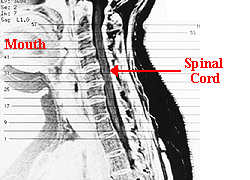| New Headrest Regulations to Prevent Whiplash |
 December 10, 2004
December 10, 2004Seatbelts and airbags are designed to protect people in case they get in a car accident. Headrests also reduce the risk of neck injuries in accidents. The US National Highway Traffic Safety Administration (NHTSA) has determined that headrests can be better. The NHTSA has issued a new safety regulation that will require headrests to be closer and higher to the head. This new regulation will be mandatory for all vehicles manufactured on or after September 1, 2008.
The NHTSA estimates that:
|
Reference and further information:
|
| GO TO: | Neuroscience In The News | Explore the Nervous System | Table of Contents |
![[email]](./gif/menue.gif) Send E-mail |
 Fill out survey |
 Get Newsletter |
 Search Pages |
 Take Notes |
 Higher headrests should reduce the number of
whiplash injuries. Whiplash is an injury to the soft tissues
(muscles, tendons, ligaments) of the head, neck and spine. These injuries
may cause neck, shoulder and back pain, stiffness, headaches, sensory
disturbances and dizziness. Damage to the
Higher headrests should reduce the number of
whiplash injuries. Whiplash is an injury to the soft tissues
(muscles, tendons, ligaments) of the head, neck and spine. These injuries
may cause neck, shoulder and back pain, stiffness, headaches, sensory
disturbances and dizziness. Damage to the